I’ve curated nearly 70 exhibitions in my time. The most challenging was Elizabeth Frink’s retrospective at the Royal Academy. Weighing in at several tons, the large bronzes are virtually impossible to shift, so I had no room for manoeuvre. To get the installation right, I placed cardboard miniatures inside a model of the main galleries and prayed they would look good full scale.
By comparison, installing Shelagh Wakely’s work at the Camden Arts Centre has been a joy – and a revelation. I thought of her as an interesting and highly original artist, but placing the work in these beautiful galleries disclosed more nuances and cross-references than I’d been aware of, and convinced me she is a major figure whose place in the canon deserves recognition. For people who have never heard of her, this may come as a surprise.
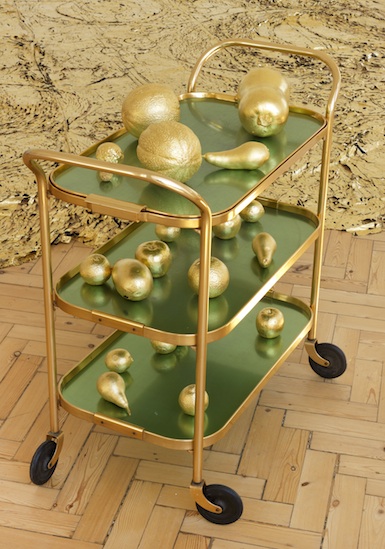 Over a career spanning 40 years, Wakely produced a wealth of exciting work in media ranging from sculptures and installations to canvases, drawings, watercolours, prints, photographs and videos. She died suddenly three years ago, leaving her studio in a state of creative chaos and the task of archiving her work fell to ROOM gallery, where she last exhibited.
Over a career spanning 40 years, Wakely produced a wealth of exciting work in media ranging from sculptures and installations to canvases, drawings, watercolours, prints, photographs and videos. She died suddenly three years ago, leaving her studio in a state of creative chaos and the task of archiving her work fell to ROOM gallery, where she last exhibited.
I spent weeks rummaging through the archive – unrolling canvases, unpacking sculptures, rifling through boxes and folders – in order to write a text for the book on Wakely (published last year by ROOM), so I knew what fascinating material was housed there. Selecting the show for Camden meant looking through everything again. Even so, unwrapping the chosen work in the gallery felt like Christmas, as each treasure was unveiled once more.
Newly framed and stretched, the drawings and large canvases look magnificent; but taking the small items from their boxes was the most exciting part. Since her work is so fragile, Wakely devised imaginative forms of packaging to protect it. Paper boxes held together with paper clips contained delicate sculptures made of tissue paper, glass, string, wire and pins. Stuffed into grubby plastic envelopes were slender glass rods welded into cubes and zig zags, swirls of the artist’s hair coiled into a bracelet, and pieces of paper and silk patterned with copper, silver or gold leaf – experiments for large scale installations, some of which we’ve recreated in the galleries and garden.
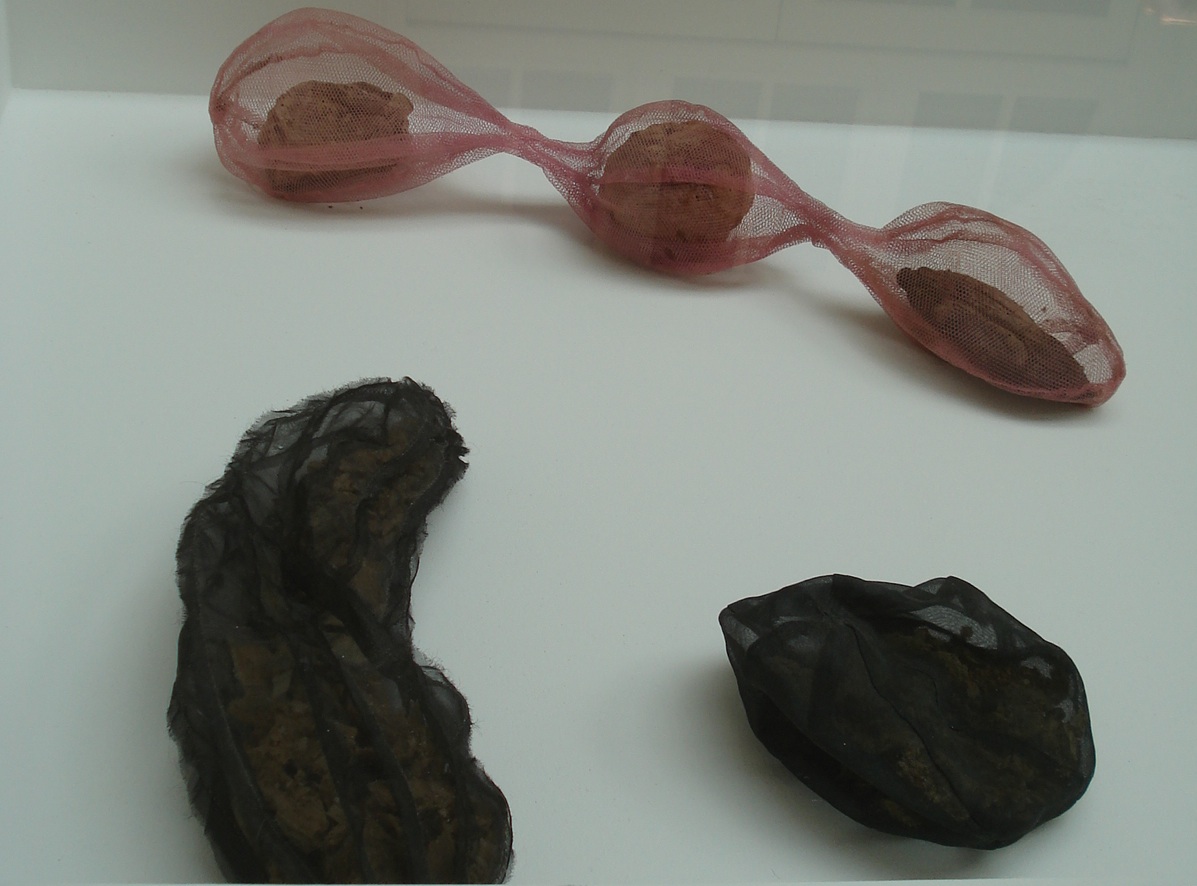 A swathe of black silk gilded to reflect ambient light turns the floor of Galley 3 into a glittering pool of gold. Alongside it on a trolley she used for the purpose, we’ve arranged the fruit and vegetables she gilded and left to rot during exhibitions in Paris and Rio de Janeiro. Entombed in thin layers of gold leaf, the tangerines, aubergines and grapefruit have long since dried into wrinkled nuggets – mementi mori for all things fresh, vital and delicious, yet destined to wither and die. A second trolley bears newly gilded fruits that will wither over the coming weeks (pictured above right).
A swathe of black silk gilded to reflect ambient light turns the floor of Galley 3 into a glittering pool of gold. Alongside it on a trolley she used for the purpose, we’ve arranged the fruit and vegetables she gilded and left to rot during exhibitions in Paris and Rio de Janeiro. Entombed in thin layers of gold leaf, the tangerines, aubergines and grapefruit have long since dried into wrinkled nuggets – mementi mori for all things fresh, vital and delicious, yet destined to wither and die. A second trolley bears newly gilded fruits that will wither over the coming weeks (pictured above right).
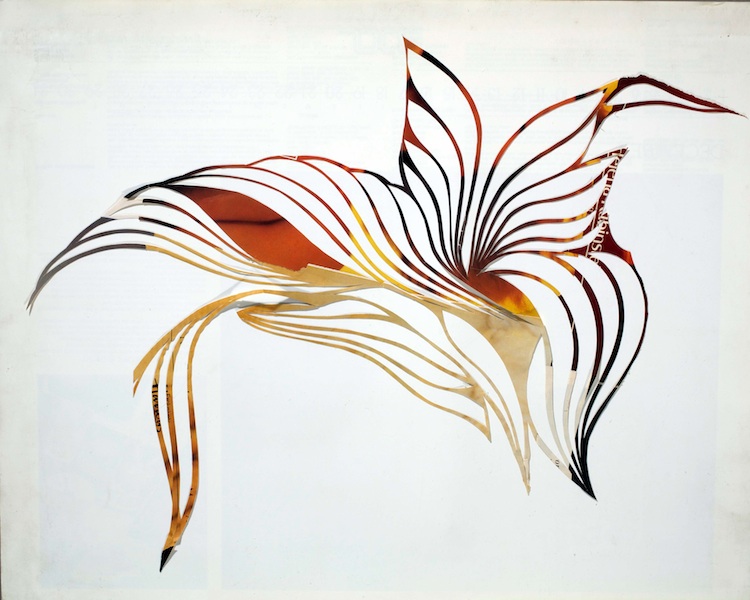 Vegetables clothed in silk have hardened inside their tailored sleeves (pictured left), while the fruits encased in cages of fine jeweller’s wire have crumbled into dust. The most beautiful of her mummifications are necklaces made from strings of cherries; nothing remains but pips, stalks and the exquisite exo-skeleton fashioned around each juicy fruit.
Vegetables clothed in silk have hardened inside their tailored sleeves (pictured left), while the fruits encased in cages of fine jeweller’s wire have crumbled into dust. The most beautiful of her mummifications are necklaces made from strings of cherries; nothing remains but pips, stalks and the exquisite exo-skeleton fashioned around each juicy fruit.
A small folder housed dozens of Nymphs – perfume ads from style magazines cut into organic shapes resembling shells, petals, furls and folds. Echoing their installation at Union Chapel, Islington in 1987, we’ve laid them out on a low plinth. Later Wakely used the cut-outs as stencils through which to sprinkle aromatic spices. In Gallery 2, a swirling pattern of sweet-smelling turmeric (pictured below) revisits a piece she made in 1991 for the British School at Rome.
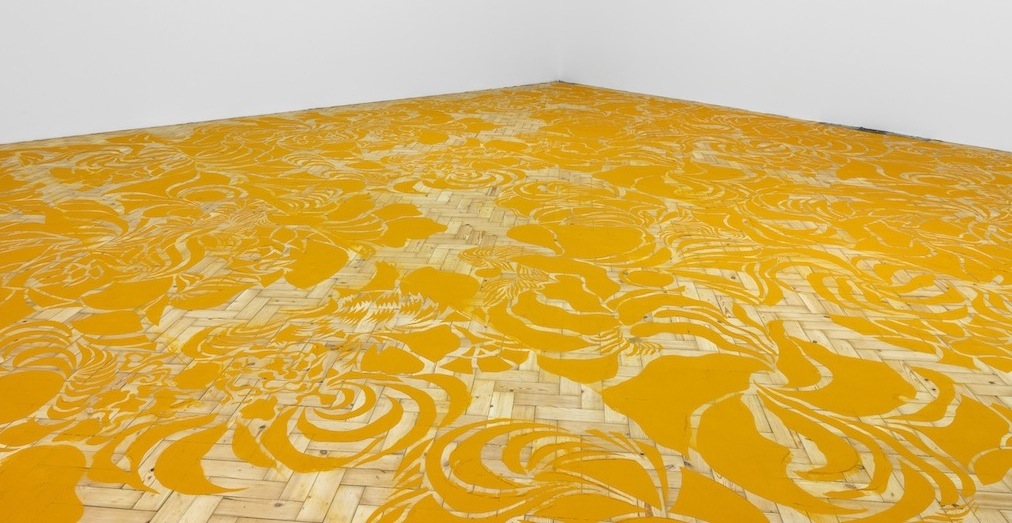 Underpinning the sensuality and unashamed eroticism of such installations is the idea of a substance escaping its confines to invade the space around it – whether perfume released from a flower, scent escaping a bottle, or liquid flowing from a glass. Seeing the work all together reveals the way she revisited ideas again and again, in different media on a small and large scale.
Underpinning the sensuality and unashamed eroticism of such installations is the idea of a substance escaping its confines to invade the space around it – whether perfume released from a flower, scent escaping a bottle, or liquid flowing from a glass. Seeing the work all together reveals the way she revisited ideas again and again, in different media on a small and large scale.
The drawings and canvases hung in Gallery 1 (pictured below) similarly explore the notion of boundaries and divisions – the interface between this and that, inner and outer, self and other. Distributed across paper or calico, hundreds of outlines of hands, feet, fruit, flowers, leaves, shells and geometric shapes delineate in ink the edges dividing one thing from another – physically and psychologically.
Transparent vessels such as bowls, cups, tumblers and jugs, which allow the gaze to penetrate the surface, are a means of exploring the erotic potential of breaching this divide and address notions of intimacy and distance, the desire to fuse and the fact of separation.
I showed her at the ICA in 1979 and, amazingly, the ceramics she exhibited there on the floor have survived intact. Using a booklet produced at the time, I was able – more or less – to recreate the installation for Camden (pictured below). During the following decade Wakely had numerous exhibitions and became well known here and abroad.
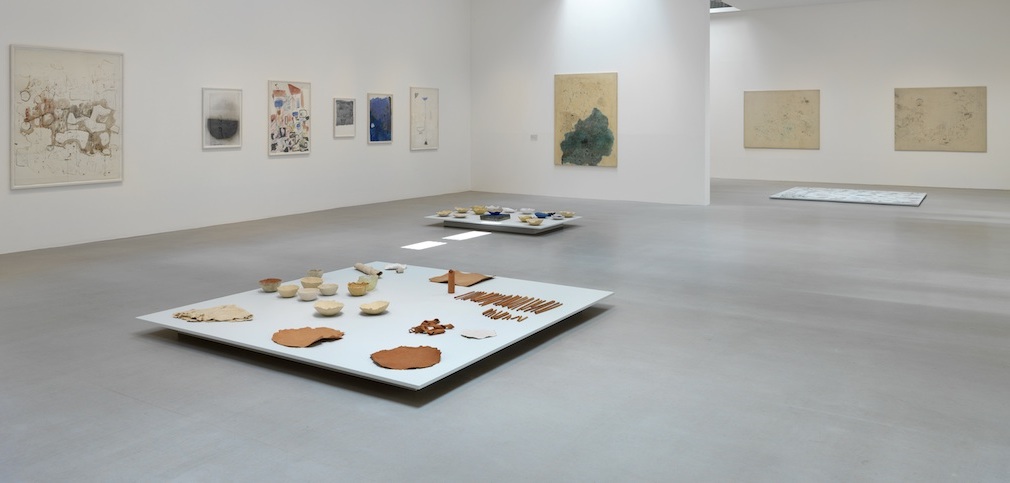 Why, then did she disappear from view? Indirectly, it was my fault. In 1989 I sent her to review an exhibition for Time Out, at the Whitechapel Gallery, of the Brazilian artist Tunga. This encounter was the beginning of a fruitful collaboration which often took her to Rio de Janeiro; she also travelled a good deal to install exhibitions as far afield as Warsaw, Prague, Paris, Mexico City, Rio and Rome.
Why, then did she disappear from view? Indirectly, it was my fault. In 1989 I sent her to review an exhibition for Time Out, at the Whitechapel Gallery, of the Brazilian artist Tunga. This encounter was the beginning of a fruitful collaboration which often took her to Rio de Janeiro; she also travelled a good deal to install exhibitions as far afield as Warsaw, Prague, Paris, Mexico City, Rio and Rome.
When she returned to London in the Noughties, she concentrated on public commissions, including a mosaic for the Royal Albert Hall. And the art world forgot about her.
Luckily, though, I visited her studio and knew she had continued doing her own work alongside the designs for hospitals and hotels. When she died, her Brazilian friends honoured her memory with an exhibition in Rio and now, with the help of Tunga, Camden is celebrating her achievement with this sumptuous survey that returns her to view and reminds the world of her enduring importance.

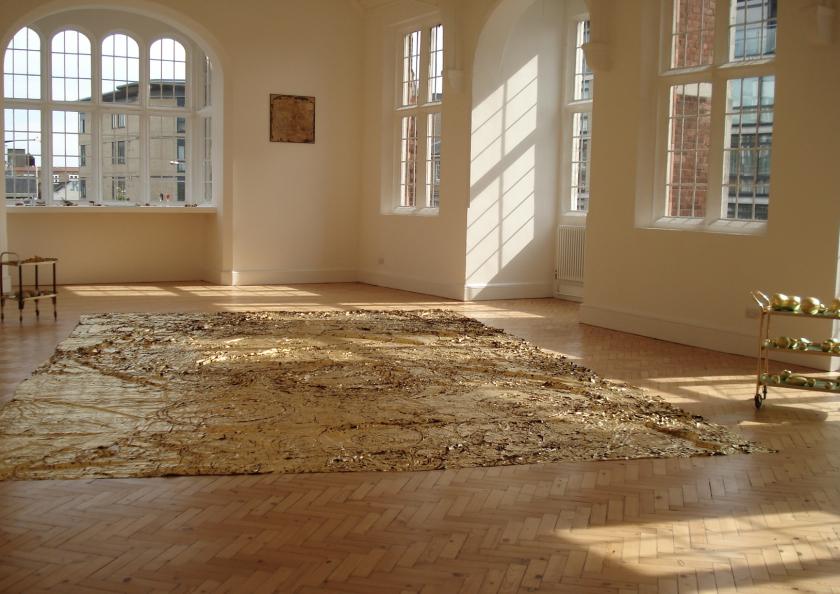







![SEX MONEY RACE RELIGION [2016] by Gilbert and George. Installation shot of Gilbert & George 21ST CENTURY PICTURES Hayward Gallery](/sites/default/files/styles/thumbnail_125_x_125_/public/mastimages/Gilbert%20%26%20George_%2021ST%20CENTURY%20PICTURES.%20SEX%20MONEY%20RACE%20RELIGION%20%5B2016%5D.%20Photo_%20Mark%20Blower.%20Courtesy%20of%20the%20Gilbert%20%26%20George%20and%20the%20Hayward%20Gallery._0.jpg?itok=3oW-Y84i)





Add comment